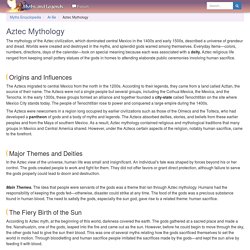

Aztec Mythology - Myth Encyclopedia - god, story, legend, names, ancient, animal, snake, war, world, creation. The mythology of the Aztec civilization, which dominated central Mexico in the 1400s and early 1500s, described a universe of grandeur and dread.

Worlds were created and destroyed in the myths, and splendid gods warred among themselves. Everyday items—colors, numbers, directions, days of the calendar—took on special meaning because each was associated with a deity. Aztec religious life ranged from keeping small pottery statues of the gods in homes to attending elaborate public ceremonies involving human sacrifice. Origins and Influences. Aztec, New Mexico Population & Demographics. Aztec, NM Demographics Follow Key findings The population density in Aztec is 2884% higher than New Mexico The median age in Aztec is 4% lower than New Mexico In Aztec 79.59% of the population is White In Aztec 0.46% of the population is Black In Aztec 0.25% of the population is Asian Find real estate listings.

Aztec Government. Before the arrival of the Spaniards on the American continent, the Aztecs had established their powerful empire with a sophisticated administrative and military structure.

The Aztec government itself derived power from the religious institution in addition to various social units including family and clan. There were various subjugated city-states in the Aztec empire that paid tribute to the emperor in the capital city of the empire, Tenochtitlan. Aztec Religion. Aztec Religion Origins & History The origins and history of the Aztec religion, just like Aztec culture and civilisation itself, can be traced back to earlier Mesoamerican cultures.

In addition to that, various deities and religious beliefs were incorporated into the system of Aztec religion with the expansion of the empire as more city-states came into its fold. According to Aztec religion, the universe was created by four major gods called Tezcatlipoca, Nanauatl, Ehecatl, and Quetzalcoatl. Aztec Religious People. 403 Forbidden. 410 Gone. What was the Geographical Location of the Aztecs? The geographical location of the Aztecs it was located in the central zone of the Valley of Mexico, from where its empire expanded to other more southern areas.

These zones occupy the current territories of the states of Mexico, Veracruz, Guerrero, Puebla, Oaxaca and the coast of Chiapas, until they reach Guatemala. Its geographical expansion was what drove the Aztec empire as a cultural reference of its time. Japanese Mythology - Gods, Goddess, Creatures and Stories. Japanese mythology dates back to more than two centuries and is an intricate system of beliefs that also incorporates the agricultural-based folk religion as well as traditional Buddhist and Shinto beliefs.

These religious beliefs originated in India and came to Japan to China and Korea. Japanese folklore have their origins in two major religions of Japan, Buddhism and Shinto. It is a collection of stories based on the legends, gods, ceremonies, practices, customs and historical accounts of the Japanese people. An essential aspect of Japanese mythology is the creation story which connects the divine origin to the Japanese Imperial family, depicting them as gods. Indeed, the emperor of Japan has also the name tennō (天皇), which means “heavenly emperor”. Japan population. The “Japanese-ness” of Religion in Japan. When one searches “Japanese religion” in a search engine, the resulting images reveal the perceptions of what religion in Japan means.

These images that reveal iconic red Shinto gates, or torii, weathered Buddha statues, and ceremonial processions at picturesque temples and shrines, are instantly recognizable as fundamental embodiments of Japanese religion. However, religion, which is defined as a certain fundamental set of beliefs and customs generally agreed upon by a group, goes far beyond archetypal structures or rituals. What Type Of Government Does Japan Have? - WorldAtlas. Japan's government is a constitutional monarchy where the Emperor's power is limited to mainly ceremonial duties.

The government has three branches: the executive, legislature, and the judiciary. The Emperor is the Head of State and the imperial family. His position does not influence the activities of the government in any way. The prime minister, therefore, is the head of the Government. Japanese Culture Facts. Japan Geographic region - Bing. ▷ Egyptian Mythology - Myths and Gods. Egypt population. What Type of Government Does Egypt Have? - WorldAtlas. What Type of Government Does Egypt Have?

Egypt is a Northern Africa country bordering four other countries including the Gaza Strip, Israel, Libya, and Sudan. Egypt manages the Sinai Peninsula, the only land connecting Africa and the other parts of the Eastern Hemisphere. The Suez Canal which is a portion of the sea linking the Mediterranean Sea and the Indian Ocean is also controlled by Egypt.
What Language Is Spoken In Egypt? If you didn’t have the faintest clue as to what language is spoken in Egypt and you had to guess off the top of your head, you might be inclined to say “Arabic,” and you would be mostly correct. However, as with every other nation-state in existence, Egypt is composed of a complex fabric of demographics and immigrant influences. Additionally, it serves as a living reminder that spoken languages can vary drastically from their written standard versions, with the spoken languages more accurately reflecting regional differences and the written standard serving as a sort of official lingua franca that unifies the whole. Modern Standard Arabic Egypt’s official language is Modern Standard Arabic, which is used in most written documents and schools.
However, Modern Standard Arabic mostly describes the literary form of Arabic, which is actually a macrolanguage composed of multiple distinct vernacular dialects. The Climate Of Egypt. Throughout Egypt, days are commonly warm or hot, and nights are cool.

Egypt has only two seasons: a mild winter from November to April and a hot summer from May to October. The only differences between the seasons are variations in daytime temperatures and changes in prevailing winds. Geographic Regions of Egypt.